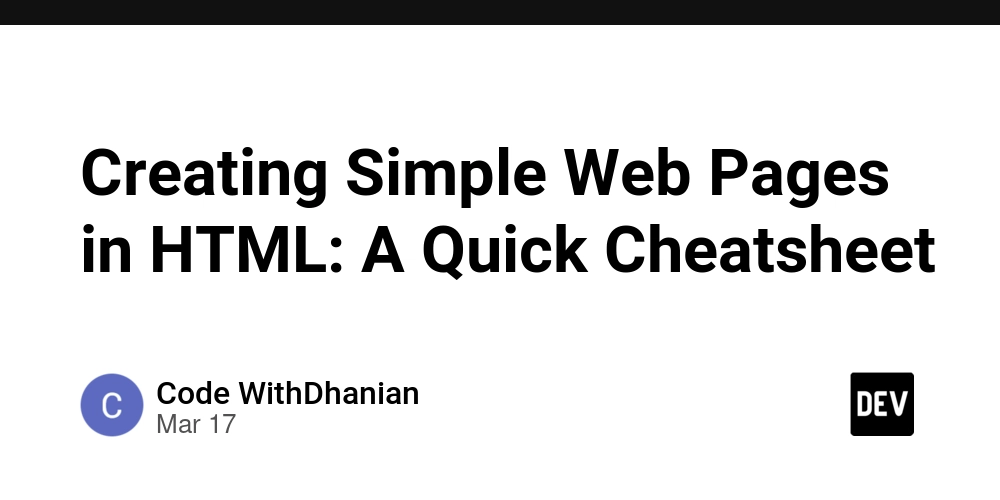Creating Simple Web Pages in HTML: A Quick Cheatsheet
HTML (HyperText Markup Language) is the foundation of web development. It provides the structure for web pages, allowing you to create headings, paragraphs, links, images, and more. Whether you're a beginner or need a quick refresher, this cheatsheet will guide you through the basics of creating simple web pages in HTML. Basic Structure of an HTML Document Every HTML document follows a standard structure. Here's the skeleton of a basic HTML page: Page Title : Declares the document type and version of HTML (HTML5 in this case). : The root element that wraps all content on the page. : Contains meta-information about the document, such as the title and character set. : Where the visible content of the web page is placed. Adding Content to Your Web Page 1. Headings Headings are used to define the hierarchy of your content. There are six levels of headings, from (most important) to (least important). Heading 1 Heading 2 Heading 3 Heading 4 Heading 5 Heading 6 2. Paragraphs Use the tag to add paragraphs of text. This is a paragraph. This is another paragraph. 3. Links Links are created using the tag. The href attribute specifies the destination URL. Visit Example 4. Images Images are added using the tag. The src attribute specifies the image file path, and the alt attribute provides alternative text for accessibility. Organizing Content 1. Lists HTML supports both unordered () and ordered () lists. Unordered List Item 1 Unordered List Item 2 Ordered List Item 1 Ordered List Item 2 2. Tables Tables are created using the , , , and tags. Header 1 Header 2 Data 1 Data 2 Forms for User Input Forms allow users to submit data. Use the tag with elements for text, email, buttons, and more. Name: Email: Additional Elements 1. Buttons Buttons can be created using the tag. Click Me 2. Line Breaks and Horizontal Rules Use for line breaks and for horizontal rules. This is the first line.This is the second line. 3. Divisions and Spans : A block-level container for grouping content. : An inline container for styling or grouping text. This is inside a div. This is a span inside a paragraph. Comments Comments are notes in your code that are not displayed in the browser. They are written as follows: Putting It All Together Here’s a complete example of a simple web page: My First Web Page Welcome to My Website This is a simple web page created using HTML. Visit Example Item 1 Item 2 Name: Conclusion With these basic HTML elements, you can create simple yet functional web pages. As you progress, you can enhance your pages with CSS for styling and JavaScript for interactivity.

HTML (HyperText Markup Language) is the foundation of web development. It provides the structure for web pages, allowing you to create headings, paragraphs, links, images, and more. Whether you're a beginner or need a quick refresher, this cheatsheet will guide you through the basics of creating simple web pages in HTML.
Basic Structure of an HTML Document
Every HTML document follows a standard structure. Here's the skeleton of a basic HTML page:
lang="en">
charset="UTF-8">
name="viewport" content="width=device-width, initial-scale=1.0">
</span>Page Title<span class="nt">












































































































































































![[The AI Show Episode 142]: ChatGPT’s New Image Generator, Studio Ghibli Craze and Backlash, Gemini 2.5, OpenAI Academy, 4o Updates, Vibe Marketing & xAI Acquires X](https://www.marketingaiinstitute.com/hubfs/ep%20142%20cover.png)



























































































































![[DEALS] The Premium Learn to Code Certification Bundle (97% off) & Other Deals Up To 98% Off – Offers End Soon!](https://www.javacodegeeks.com/wp-content/uploads/2012/12/jcg-logo.jpg)


![From drop-out to software architect with Jason Lengstorf [Podcast #167]](https://cdn.hashnode.com/res/hashnode/image/upload/v1743796461357/f3d19cd7-e6f5-4d7c-8bfc-eb974bc8da68.png?#)









































































































.png?#)

































_Christophe_Coat_Alamy.jpg?#)
 (1).webp?#)




































































































![iPhone 17 Pro Won't Feature Two-Toned Back [Gurman]](https://www.iclarified.com/images/news/96944/96944/96944-640.jpg)
![Tariffs Threaten Apple's $999 iPhone Price Point in the U.S. [Gurman]](https://www.iclarified.com/images/news/96943/96943/96943-640.jpg)

































































































































